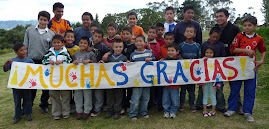We knew that installing the plastic sheeting on the greenhouse wouldn't be that easy with just ladders, so we rented two sets of scaffolding to make the job safer and easier.
When we got started early on April 24, we were in good spirits, the weather was good, and we thought we were prepared. By the end of the day, we were cold, wet, tired, and rather daunted by the task that still lay ahead of us.
It all sounded pretty straightforward - tack down the end of the sheeting, pull it tight, and then secure it. But we didn't fully appreciate the issues of alignment, the number of times that we'd have to move the scaffolding and ladders, nor how hard it is to drive nails into seasoned eucalyptus wood, etc. etc.
About mid-morning, while we were patiently working through our issues, the weather turned sour, and it started raining and blowing.
 |
| Henry Rairan, staff member for IMiC, tensioning the plastic at the eve level, and securing it with staples to a guy wire. We have secured the first sheet of plastic and the rain is falling. |
We weren't about to be daunted by a little bad weather, so we pressed on. We had installed the first sheet of plastic along the length of the greenhouse by lunch time.
After lunch, a group of boys came down to help. Based on a good suggestion by Henry Rairan, we altered our procedures, now tensioning and securing each section of the roof plastic to the truss one at a time, instead of trying to cover the whole length of the roof at once. This worked better, because we could easily gain access to nail the little strips of wood to the top of each truss along the way, rather than trying to do so from the edges after the whole length of plastic was in place.
But after we'd installed one section of the second sheet this new way, the rain and wind really let go. We knew we couldn't just let the plastic ride out the storm, because it would get shredded for sure. So we blundered along, soon working with soaking wet clothes, numb fingers, and boots caked with mud. Every movement became harder. Most of the crew huddled under the completed sheet of plastic roofing while a couple of others stapled, hammered, and pulled sheeting out in the rain. Late in the afternoon, the storm abated, just about the time that we finished securing the second sheet. We started to install more cables in order to secure the edges of the plastic into gutters, but ultimately decided it was too late and that the loose edges wouldn't be damaged over the weekend.
 |
| Here's how the south bay of the greenhouse looked after a hard day of installing plastic. Note the muddy ground and tired workers. |
So we put everything away and tried to figure out how to make our efforts more productive next week.
We left, thankful that we didn't suffer any accidents or injuries working up at the 4+ meter heights during the difficult conditions, and thankful also for the best efforts of the entire crew in facing this challenge.


































